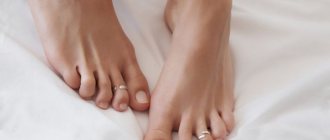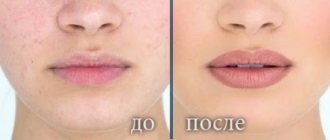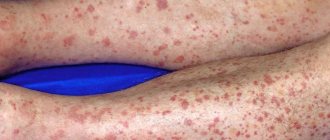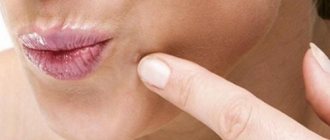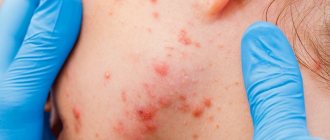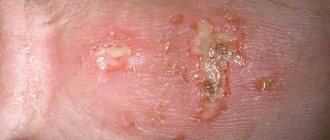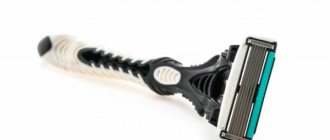How do they look
Fordyce spots visually look like yellowish granules or swellings that are clearly visible on the lips.
The main area of their concentration is the area near the sebaceous ducts. They are located not on the surface, but under the skin. At their core, they are sebaceous formations that gradually accumulate and form something like a bubble or granule. They were first discovered and studied by dermatologist John Addison Fordis (a specialist from the USA). He was the first to give a detailed description of formations in medical literature.
The granules are similar in size to grains of rice. Most often, neoplasms appear in size about 1-3 mm. 1-2 pieces are formed or combined into a group of 20-30 papules. Clearly noticeable when smiling (stretching lips). They do not contain or spread bacteria or viruses. In medicine, the phenomenon is classified as a skin condition, but not a disease.
The main harm to a person is psychological discomfort . Research statistics show that the problem is present in 36% of women and 60% of men. The age when granules may first appear is 13-16 years. Age corresponds to a period when the body undergoes rapid changes in hormones.
Kinds
Fordyce granules on the lips do not require strong exposure to antibiotics or special treatment with hospitalization. They should be removed if there are too many formations.
Doctors distinguish the following types of vesicles :
| Possible sizes |
|
| Colors |
|
| Peculiarities |
|
| Location |
|
By location
Location on the inside of the lips
According to this feature, granules can be located:
- on the outside of one lip;
- on the outer side of the two lips;
- on the inside;
- from each side;
- in the center;
- On the sides;
- closer to the cheeks (from the outer and inner sides).
They can feel either smooth or rough to the touch. By size - small or large.
By shape
One of the forms of formations
There are several different forms of formations:
- cysts;
- cones;
- granules;
- spots;
- granules;
- bloating.
Sometimes they are shaped like small, light-colored pimples (they have no volume).
By stage
Granules are divided into stages of development (appearance):
- present from birth (visually invisible);
- appear on the skin at the time of puberty (on average 13-16 years);
- during the period of growing up, at an older age they become clearly visible upon visual inspection.
The impetus for development or increase in quantity is given by hormonal changes in the body. Doctors believe that closely located sebaceous glands or their incorrect location - at the very edge of the lips or mucous membrane - contribute to the formation of nodules. At older ages (after 45 years), the number of sebaceous glands increases. At this stage, the granules become visually similar to white cones.
Important! In some cases, granules are confused with protruding herpes. The main difference between these formations is that herpetic manifestations look like a cluster of blisters. Inside contains a clear or light yellow liquid. Over time, they burst and become crusty.
What to prepare for, does it hurt to do permanent makeup?
Fordyce granules and permanent makeup are compatible in the absence of contraindications to tattooing. Despite the minimally invasive procedure, many girls find it painful. To reduce pain, the master applies an anesthetic cream to the lips under the oilcloth for 10-15 minutes. But the effect of local anesthetic drugs is short-term, which is why during the process of introducing the permanent it is necessary to pause for repeated anesthesia.
Primary permanent makeup is less painful than correction. Before repeating the procedure, it is better to take a potent analgesic in tablets or inject an anesthetic drug.
Even a dental anesthetic is suitable, thanks to which the lips will become numb and insensitive to pain.
Causes of appearance, who is at risk
Experts believe that the main reason for the appearance of formations on the lips is the incorrect (abnormal) location of the sebaceous glands.
There is no exact information about the mechanics of their appearance, but doctors identify additional reasons and factors that may affect the development of the negative process:
- certain types of hormonal disorders - from temporary imbalances (due to medication) to serious diseases or complications;
- metabolic changes in the system or in the body as an integral structure;
- adolescence (puberty, the beginning of menstruation in girls);
- hyperlipidemia - the problem is a lipid disorder that is directly related to increased body fat;
- disruptions in the blood circulation process occur - as a result, the accumulation and expansion of the sebaceous glands on the surface of the skin occurs;
- genetic predisposition - the problem passes from parents to child in 90% of cases;
- skin pores are too large and clogged . Oil from the sebaceous glands can form plugs and blockages. Such conditions are ideal for the formation of Fordyce granules;
- the natural process of aging of the body - after 45-50 years, a gradual decline in metabolic processes begins, even without disturbances on the part of the body. Under these conditions, subcutaneous fat can accumulate and be deposited 2-3 times faster;
- the process of infection of the sebaceous glands - if a bacterial or fungal infection has penetrated them, then the appearance of white or yellow spots can be traced in 90% of cases. This is due to the reaction of the glands to pathogenic conditions and microorganisms;
- hormonal imbalance , a disorder due to an existing disease. In 90% of cases, the problem is a symptom of a problem such as a dysfunction or disease directly related to the functioning of the thyroid gland;
- menopause (the likelihood of rashes increases in women after 55 years);
- dysfunction of the glands;
- injury to the lip area;
- consequences (complications) of the enlargement process using hyaluron ;
- pregnancy - manifestations can occur at any week, since each woman’s body works individually;
- disruption of the adrenal cortex;
- ovarian diseases (pathological nature or consequences of age-related changes);
- disorders of the hypothalamic-pituitary system;
- the presence of habits that in 90% of cases cause harm to the body (smoking in 90% of cases);
- consequences of surgery on the endocrine glands;
- stenosis of the sebaceous gland ducts.
Problems such as being overweight or poor personal hygiene do not lead to the formation of granules on the lips. It has been noted in studies that reducing body volume (weight loss) leads to the disappearance of tumors or makes them less noticeable on the skin.
Reference! Granules in any form and quantity are not a consequence of past or existing sexually transmitted diseases and are not sexually transmitted.
Why do Fordyce granules appear, where can they be and how to get rid of them:
Symptoms and external manifestations of pathology
In order to take measures to remove tumors, you need to know the symptoms of the problem. Under normal conditions, the sebaceous glands under the skin are not visible, but if the prerequisites are present, the granules become visually noticeable.
In addition, there are other symptoms :
- bulges appear;
- formations at the very beginning have a reddish tint, then change color to white or yellow;
- formations can be single or collected in groups;
- in 90% of cases there is no itching, but sometimes it may be present;
- discomfort appears in the damaged area;
- formations may be present in small quantities on the skin nearby (lower near the nose, on the chin);
- in rare cases (20-30%), swelling appears at the site of the rash and a burning sensation;
- lips become faintly pink, sometimes have a yellowish tint.
The formations are easily visible through the skin when stretched (smile, exercises for facial wrinkles). If one or more of these symptoms appear at the same time, it is recommended to consult a doctor, cosmetologist, or undergo examination by a dermatologist.
Attention! You should not try to squeeze out the granules, as there is a high probability of infection getting under the skin.
Is it possible for acne to appear on the lips?
Acne is a disease of the sebaceous glands. Since there are very few of them on the red border of the lips, the likelihood of acne forming in this area is low. But acne can form in the area around the lips. If a dermatologist has diagnosed acne, he may prescribe azelaic acid preparations for treatment9. Azelik® belongs to this group of drugs. This is a 15% azelaic acid gel with the following properties5:
- the ability to normalize keratinization processes in follicles;
- anti-inflammatory effect exerted by reducing the metabolism of neutrophils and the free radical forms of oxygen they produce;
- reduction of free fatty acids in skin lipids;
- antimicrobial activity against propionibacteria and Staphylococcus epidermidis.
The results from the action of Azelik®, as a rule, become noticeable after 4 weeks of using the drug5.
Can I cope on my own or should I consult a doctor?
You can get rid of the problem yourself if a person has knowledge in the field of cosmetology and dermatology. It is best not to try to get rid of the problem yourself , since symptoms may indicate the presence of specific problems in the body that require professional solutions and constant medical supervision.
You should not delay your consultation if there is obvious discomfort when talking or eating. The appearance of discharge or blood from the granules, increasing itching or pain also indicates the need for a medical examination.
Diagnostics
To undergo a diagnostic examination, you must first visit a therapist . He will give referrals to doctors of narrow specialization: dermatologist, endocrinologist . Women will also need to be examined by a gynecologist to confirm or deny the causes of the rash.
If the number of granules is small - 2-5 pieces, then a specialist in most cases makes a diagnosis immediately after a visual examination. There is no need to take tests or undergo hardware diagnostics (except for controversial issues or doubts).
When the rashes are profuse, in addition to discomfort, there is also itching, then a detailed examination, tests and specific procedures are mandatory for making a diagnosis and starting treatment. Additional examination is carried out in order to exclude the possibility of medical error. It is easy to attribute the granules to manifestations of eczema, rashes of an allergic nature, neurodermatitis, or molluscum contagiosum.
The main method of examination is taking a skin sample from the damaged area (biopsy) . Additional tests (general blood and biochemical) may be required if the doctor suspects the development of lichen ruber. Also, tests are prescribed by specialized specialists (for hormones, examination of the thyroid gland) when there are suspicions or additional symptoms characteristic of the disease.
Important! Despite the abundance of rashes, the quantity or color of the granules does not pose a health hazard. The main disadvantage is the visual unaesthetic. The transformation of neoplasms into malignant types of tumors (cancer) has not been detected over all the years of observation and examination.
Getting rid of Fordyce granules at home
In case of mild cases, treatment can be carried out at home. For this purpose, folk recipes and knowledge based on the properties of plants are used. The main components are herbs and various essential oils.
The knowledge accumulated in society is not the main method of treatment. It is recommended to use them as an addition to a recovery program that is based on modern medications. Together, each element will work 20-30% more efficiently.
Methods and methods for getting rid of white rashes at home:
- the presence of itching or discomfort can be removed with cold compresses based on chamomile infusion. For 250 ml of water you will need 1 tbsp of dried flower. You will need to wipe your lips 2 times a day (it is more convenient to carry out the procedure in the morning and evening);
- medicinal ointment - it is based on natural honey, mumiyo (you can use crushed tablets) and fir oil. You need to lubricate your lips with the composition 2 times a day. As a result of application, severe discomfort disappears;
- essential oils (fir, grapefruit, tea tree) help remove swelling or a burning sensation, and they also help get rid of or reduce pain.
If home therapy works at the source of the problem, the skin in the damaged area will begin to darken. After 1-2 weeks, the rashes will begin to subside. Gradually they will disappear completely. The skin will regain its natural shade. You can also apply baked onions to the areas. A solution of propolis or a mixture of fir oil with the addition of 2-4 drops of iodine copes well with the problem.
Important! Traditional recipes contain components that can cause an allergic reaction - plants, herbs, honey and ethers. Before using formulations or components, you should consult your doctor for detailed advice.
At the cosmetologist's
A visit to a beauty salon can also be a step towards getting rid of the problem.
The procedures are minimally invasive (without the use of surgical instruments). No specialized patient preparation is required. Hygiene rules are observed and antiseptic agents are used during the process. If pain relief is required, it is performed locally. The main medications are sprays containing lidocaine.
A specialist can use one or more techniques :
- laser treatment of the area - bulges under the skin are eliminated by targeted radiation. There is no pain or discomfort felt during the process. The effect is on the upper layers of skin and fat accumulations. The chance of bacteria or virus penetration with this technique is less than 1%. A special point: after exposure, the area becomes covered with a crust (a scab is formed). You cannot remove or try to rip off the formation - in this case, the likelihood of infection increases. The crust will fall off on its own in 3-5 days;
- method of exposure to radio waves - acts similar to laser exposure. High frequency waves. The crust also falls off on its own. This takes up to 10 days;
- exposure to liquid nitrogen is rarely used, since it is very difficult to control the strength and depth of exposure to the substance. Used as a fallback method when other programs do not produce results.
During the recovery period, no special impact on the wounds is provided. The duration of the course is calculated individually and depends on the severity and stage of the problem.
How to get rid of pathology:
In the hospital
There is no need to go to the hospital specifically - treatment is carried out on an outpatient basis.
The main drug for recovery is products that contain vitamin A. The doctor can prescribe:
- cream;
- gel;
- solution.
Additionally, other skin imperfections (acne or inflammatory processes) are also eliminated. Pigmentation becomes less pronounced. The composition chosen for treatment is applied with gentle movements. The layer should be thin. This is required for free air circulation.
The duration of drug treatment is individual. The doctor develops a course based on the examination results. If treatment for a specific disease is required, hospitalization may be required as indicated.
Advice! It is better to apply creams and ointments at night, as they should act on the skin for 5-6 hours.
Treatment methods for Fox-Fordyce granules on the labia
Fordyce granules in women, which do not cause concern or discomfort on the lips major and minor, can be removed using conservative and cosmetic methods. The first involves the use of various medications without mechanical removal. Cosmetological methods are more effective. They are used for multiple formations on the genital areas and the ineffectiveness of conservative therapy. Low and high temperatures and laser radiation are used. There are also a number of traditional medicine recipes that allow you to remove white nodules on the female genital organs: pubis, lips, vagina.
Conservative
At the moment, there are no drugs that have a targeted effect on the pathogenetic mechanisms of the appearance of J. Fordyce granules in the area of the intimate lips. In medical practice, various oils are used (fir, jojoba, etc.), and retinoic ointment and multivitamins: improve the condition of the skin and mucous membranes, normalize the functioning of the sebaceous glands. With the help of conservative treatment, it is possible to slightly reduce the number of granules on the woman’s genitals.
Cosmetology
Methods involving mechanical removal of the Fordyce defect on the intimate lips are effective. Currently, removal is performed using laser, cryodestruction and electrocoagulation.
Need advice from an experienced doctor?
Get a doctor's consultation online. Ask your question right now.
Ask a free question
Radiation removal is carried out in case of damage by Fordyce granules to the genital organs (lips, pubis, vagina), with an area of no more than 5 mm. A carbon dioxide laser system is used. A beam of light is directed at the formations and burned out one by one. There is a sharp increase in temperature in the cells, which leads to the evaporation of fluid and destruction of tissue in the genital area. A crust forms on the surface of the lips, which will fall off over time, and healthy mucous membrane will be restored under it.
The procedure is painful and local anesthetics are used. It will not be possible to remove all John Addison Fordyce granules from the intimate lips in one session; you will need to repeat the procedure several times.
Cryodestruction of Fordyce granules is based on the effect of low temperatures on the blood supply to the genital tissues of the lips. Using an applicator whose temperature reaches -125-150 degrees, the area of the mucous membrane where the granules are located is frozen. The treated area is then warmed up and freezing is repeated. This leads to spasm of blood vessels and tissue death in the genital area of the lips. A bubble appears at the site of the procedure, which subsides over time. In place of Fordyce's nodules, normal mucosa appears.
Electrocoagulation is performed using a heated electrode. High temperature causes tissue destruction with simultaneous cauterization of blood vessels, so the procedure for removing Fox-Fordyce granules is bloodless. It is performed with local anesthesia.
After removing nodules on the intimate lips, you should refrain from sexual intercourse for a month until the mucous membrane is restored.
Folk
Traditional methods of treatment can be harmful to health; before using them, it is recommended to consult a doctor.
To treat J. Fordyce granules on the intimate lips, recipes based on medicinal herbs that have a bactericidal, astringent and anti-inflammatory effect are used.
Chamomile, sage and a succession of 1 tablespoon each, mix and pour 0.5 liters of boiling water. Then leave to infuse for an hour, then strain. Apply to cotton wool and treat the labia majora and labia minora. You can take a bath with the infusion. The course of treatment is a week.
You can prepare an infusion of calamus and St. John's wort. Take vegetable raw materials in equal proportions, pour boiling water, leave for 1-2 hours. Use the resulting infusion to wipe the areas affected by J. Fordyce granules.
Treatment
The treatment process is aimed at eliminating cosmetic imperfections. The peculiarity is that after 40-45 years the formations can resolve on their own . The reason is a decrease in activity in the functioning of the sebaceous glands.
The main doctor is a dermatologist. There will be no complications from the effects produced. No surgical intervention is performed. If medications do not produce results, then correction is carried out with a laser or radio wave.
Medication
Treatment of pathology with medications is indicated when the formations are small in size (about 1 mm).
For this, Retin A ointment or other similar compositions are used. The main component is jojoba oil, as well as retinoic acid. Indications for use:
- neoplasms under the skin;
- acne;
- preventive effects on the skin to prevent early aging;
- presence of facial wrinkles;
- consequences of prolonged exposure to the sun.
Retinoic acid has an exfoliating effect on the skin. The plugs formed as a result of the accumulation of fat dissolve under the influence of the substance. It is also used when it is necessary to remove or make scars less noticeable.
The areas need to be processed according to the following algorithm:
- rinse the skin;
- dry;
- Apply a small amount of product to the damaged area;
- do not wash off;
- stand for about half an hour (according to indications);
- wash off.
A side effect of the drug is sometimes a slight burning sensation on the skin of the lips after applying it to the granules. This does not require its cancellation. If the sensations are significant, then treatment is carried out once every 3 days.
The course of drug treatment starts from 1 month. Additionally assigned:
- vitamin complexes;
- procedures to stabilize the state of hormones;
- physiotherapy.
As a result, you can visually observe how the secretion of the sebaceous glands returns to normal. Additionally, antihistamines may be prescribed to eliminate the possibility of an allergic reaction.
Patient about the treatment of Fordyce spots:
Folk remedies (recipes)
Oil compositions: jojoba and water in a ratio of 1:2. The composition must be applied in the form of a mask. Leave for 20 minutes, then rinse with warm water. There is no need to use soaps or foams for washing.
A solution based on dried chamomile tincture. The liquid is used as a composition to wipe the damaged area.
Citrus juices - orange and lemon. You need to take a quarter of each type and mix. Using a cotton pad or soft cloth, apply it to your lips. Repeats throughout the day – 3-4 times. The course lasts until the spots disappear.
Apple cider vinegar and water is a simple recipe for pronounced granules. Quantity:2:1. Usage: Apply with a cotton swab to the treated area. Leave on lips for 10 minutes, then rinse with warm water. Repeat 1-2 times a week. Continue the procedure for an individual period - until the granules completely disappear.
The healing properties of olive oil are actively used in folk medicine. They help remove or reduce the severity of formations. Softening and moisturizing the skin, cleanses pores. As a result, the sebaceous ducts are not clogged, and the movement of fats occurs freely. Olive oil is applied to clean and dry skin. It is best to leave it on for 6-8 hours (so the best solution is to apply it at night).
Another simple but effective traditional medicine: fresh garlic juice . You need to squeeze the liquid onto a cotton swab and wipe your lips. Then rinse with water without using soap or other cosmetics.
Removal
The method is used only after all the methods of cosmetologists have been tried and available folk recipes have been applied.
In 90% of prescriptions one of the following methods is present:
- plastic (surgery);
- micro-impact surgery;
- chemical cauterization;
- cryotherapy.
Modern medical methods offer to cure the problem:
- Electrocoagulation. The impact of currents in this case is insignificant, since the formations are located in the upper layers.
- Liquid nitrogen cryotherapy is used as a definitive approach.
- Granules are excised with a laser when other methods have failed.
- Wave action removes formation by 100%. There are no traces, scars or scars left.
Electrocoagulation
Cryotherapy
Laser
Radio waves
Introduction
Fox-Fordyce disease (FFD), also known as apocrine miliaria or chronic pruritic papular disease of the pubic and axillary regions, affects areas where apocrine glands predominate, such as the pubic, axillary, and anogenital regions (1, 2).
The pathogenesis remains unknown, and the disease primarily affects young women (3).
Commonly used treatment methods are little or partially effective, since the rashes often recur and symptoms persist.
Two cases with a clinical and histopathological diagnosis of perifollicular xanthomatosis are presented.
CLINICAL CASES
CASE 1
A 33-year-old patient, a resident of Mexico City with no chronic diseases, reported the appearance of multiple mildly itchy papules in both armpits over the course of a month. The patient reported hyperhidrosis and no previous treatment.
Physical examination revealed a localized, bilateral, asymmetrical rash on both axillae, more prominent on the left, characterized by yellowish-brown punctate papules, 1 mm in diameter, with a smooth, uniform surface and a follicular pattern (Figure 1).
Histopathological examination with H&E staining showed dilation of the follicle infundibulum with a horny plug, as well as an inflammatory lymphohistiocytic infiltrate with xanthomatous cells surrounding the infundibulum (Fig. 2).
Mucin deposits were observed intrafollicularly and around apocrine glands when stained with Alcian blue.
Immunohistochemistry showed that the perifollicular cells were strongly CD68 positive. Carcinoembryonic antigen and epithelial membrane antigen were negative in xanthomatous cells (Fig. 3).
FFD was confirmed and topical clindamycin was started with improvement of symptoms.
CASE 2
A 24-year-old female patient, a resident of Leon, Guanajuato, Mexico, developed intensely pruritic papules in both axillae and the genital area for about two years.
The patient had previously been treated with antihistamines and emollients without any improvement. The patient reported that other women in her family had the same skin condition in the armpits, although less severe.
The patient had a history of comedonal acne on the face and trunk for about 12 years, as well as menstrual irregularities with amenorrhea for up to 2 months. Therefore, an ultrasound of the pelvic organs was prescribed, which showed polycystic ovaries.
Physical examination showed a disseminated process involving the axillae and genitals, areas of hair growth, characterized by pinpoint papules the color of normal skin with a diameter of 1 to 2 mm with a follicular arrangement and crusts on the surface of some elements (Fig. 4).
Histopathology showed dilated infundibulum with hyperkeratosis as well as xanthomatous histiocytes with a perifollicular distribution and a discrete inflammatory lymphocytic infiltrate. Intrafollicular mucin deposits were also observed (Fig. 5).
FFD was diagnosed and combined oral contraceptives (cyproterone with ethinyl estradiol) and topical hydrocortisone were prescribed with partial improvement of the skin process and reduction of itching.
DISCUSSION
Fox-Fordyce disease was first described in 1902 by American authors George Henry Fox and John Addison Fordyce (1, 2).
The pathogenesis of this disease remains unknown, although proposed theories suggest that hormonal factors, hair removal, and heredity may be important factors in apocrine obstruction, sweat retention, and inflammation (3, 4).
This disease is represented by a characteristic clinical picture of damage to the area of the body where the apocrine glands are located, such as the axillary fossa, pubis and anogenital area.
However, less common sites have been described on the skin of the breast, nipple areola, abdomen, and lower extremities (5).
The disease occurs mainly in women aged 15 to 35 years and usually regresses during menopause (6).
In our clinical cases, we report typical rashes affecting the axilla and genitals, without any rashes on other parts of the body. Both patients were women of childbearing age.
Clinically, FFD is characterized by the presence of multiple follicular papules of normal skin color, slightly yellowish or brown, dome-shaped, with a smooth surface, which may be accompanied by mild to moderate itching, or even be asymptomatic.
Exacerbating factors include heat, humidity, physical activity, friction from clothing, and excessive sweating (7). Laser hair removal and intense pulsed light have also been described as triggers (4, 8). The rashes typically have a chronic course, lasting weeks to years (7).
Differential diagnoses include Piccardi-Lassoueur-Graham-Little syndrome, trichostasis spinulosa, Darier disease, syringomas, lichen lineara, lichen amyloid, and papular mucinosis (9, 10).
Definitive diagnosis is made by histopathological examination, which may show nonspecific findings such as intrafollicular corneal plug, hyperkeratosis, spongiosis, retention vesicles, dilated glands with mucin deposits, and perifollicular lymphohistiocytic inflammatory infiltrate (11, 12).
The presence of infundibular dyskeratotic cells, vacuolar changes, and parakeratosis similar to the stratum corneum has also been described (13).
However, Bormate et al. the presence of foamy or xanthomatous histiocytes (perifollicular xanthomatosis) has recently been described as a distinctive and more specific feature of this pathology (13).
This was confirmed in the histopathology of our cases, as both presented previously described findings, particularly xanthomatous histiocytes as well as intrafollicular mucin deposition.
Response to treatment tends to be partial; rashes and symptoms may recur or persist.
First-line treatment includes topical and oral retinoids, benzoyl peroxide, topical calcineurin inhibitors, clindamycin, systemic or topical steroids, and oral contraceptives, with complete resolution of the lesions (14).
In our first case, the patient was treated with topical clindamycin, achieving partial improvement of the rash and symptoms. In the second case, the patient was treated with combined oral contraceptives and topical hydrocortisone, achieving partial improvement of the lesions and pruritus.
Alternative treatments as second-line therapy or in severe cases, such as botulinum toxin, phototherapy, electrocoagulation, copper-CO2 laser, liposuction, curettage, and microwave therapy, have been used with good results (10, 15).
We reported two cases, both with perifollicular xanthomatosis on histology, supporting the position that this is the most specific and distinguishing feature of this relatively rare disease.
Can they appear after lip augmentation?
In rare cases, granules may appear after a lip augmentation procedure . This is due to the fact that hyaluronic acid is used as the main component. The body reacts to its excess or presence. As a result, characteristic thickenings form on the lips.
Granules appearing after lip augmentation procedure
Is it possible to get a tattoo with this pathology?
Since cysts do not contain any infection, their presence is not a contraindication to tattooing (permanent makeup). A similar approach is used to visually hide a problem when treatment has not produced the desired results.
Tattooing will help hide the defect
Advantages of permanent makeup for masking Fordyce granules
The method of introducing a permanent under the skin of the lips is minimally invasive. It rarely causes side effects or complications. Permanent makeup allows you to evenly tint your lips with a slightly darker shade than their natural color. The granules are also painted to match, making them visually invisible. Another advantage of the procedure is its cost. Most often, only 1 session is required to achieve the desired result, less often – 2.
Fordyce granules can be eliminated not only medically, but also cosmetically, using permanent makeup.
Correction is carried out only after 3-4 years, and in 20% of women, the result of makeup lasts more than 5 years.
Possible complications
No significant changes in health status are observed. After the spots disappear, the situation can go in two ways:
- the condition of the skin will improve, as hormonal levels return to normal, the functioning of the sebaceous glands is stabilized;
- the condition will become worse than before the appearance of the granules. In most situations, this is due to age factors (the skin goes through the aging stage).
Doctors recommend not to resort to serious impacts on formations if they do not cause severe discomfort.

